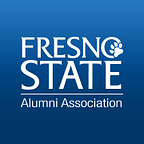Taking flight: The legacy of Fresno’s own Tuskegee Airman
By MARISA MATA, Student Writer
“He had a scar on his leg he liked to talk about, said it was where the Germans shot him through his plane,” Patricia Dawson says of her father, Herman “Ace” Lawson (Alumnus).
Dawson and two of her sisters, Betty Davis and Yvonne Warren, are visiting the Unsung Heroes exhibit at Fresno State’s M Street Graduate Art Studio, honoring African American World War II veterans. Lawson was a Tuskegee Airmen — one of the first African American pilots in the country, flying during World War II.
As you enter the exhibit, there’s a table to your right. Covering it are framed black and white photos of veterans in their uniforms. There are both men and women.
You walk down a narrow hallway where two large paintings are hanging. In them, Lawson is flying his plane, named “Ace of Pearls.”
Lawson attended Fresno State in the late 1930s, where he met his wife, Pearl Lee Johnson (Alumna). They were two of three African American students at Fresno State at the time. Johnson studied to become a teacher. Lawson was a photographer and a football player, the first African American to play four years of football at Fresno State. It was also during his time at Fresno State that Lawson decided he wanted to be a pilot in the Army Air Corps.
“He had a friend who was a pilot, who took him up on a plane ride,” Davis says. “He liked the adventure and excitement of it, and decided that was what he wanted to do. He wanted to fly.”
Lawson went with a group of friends to be interviewed for the Air Corps. After waiting for an hour to speak with the major, he was told to leave, the Army wasn’t looking for night fighters.
He wrote to Congress. He wrote to First Lady Eleanor Roosevelt. He wrote to President Roosevelt.
Finally, he had an opportunity to fly — in Tuskegee, Alabama.
Johnson went to Tuskegee in 1942 to pin on Lawson’s wings. They were then married at the chapel on the Army base.
Lawson flew over 100 missions with the Tuskegee Airmen from 1942–1945, and had to bail out of his plane twice — once over the Mediterranean, where he was rescued by the Navy.
Davis says, “Most of the missions he had, he flew out of Sicily and North Africa into Germany. He protected bombers going into Germany. They weren’t supposed to leave their side.”
For his service during World War II, Lawson received the Distinguished Flying Cross, the Distinguished Service Cross, a Silver Star and a Congressional Gold Medal from President Bush, which Davis accepted on his behalf in 2007.
Lawson flew in the military for a total of 25 years. He later served on the city council in Sacramento, where he also started a chapter for Tuskegee Airmen.
“He stayed in touch with other Tuskegee Airmen, and formed the chapter to preserve the legacy, keep history alive. He wanted to make sure people knew about the experiences of the Tuskegee Airmen.”
“I was talking to a woman in the chapter, another daughter of a Tuskegee Airmen, about how our fathers are famous. We didn’t realize it growing up, but we know now,” Davis says as she admires a photo of her father, positioned in the middle of a wall in a large room, among others of Tuskegee Airmen.
In 1991, Davis visited an exhibit at the Smithsonian where her father’s bomber jacket is. People there were eager to take pictures with her, the daughter of a Tuskegee Airmen.
Lawson passed away in 1995. Davis says her father often talked about the war and the Tuskegee Airmen while she and her siblings were growing up. “He liked showing his pictures and movies. He had a lot of pictures he took of the war and the people, Italy in particular.”
“He would have been very, very excited [about the Unsung Heroes exhibit]. I think he would have loved this. He would have loved that there’s people learning about the Tuskegee Airmen.”
Related:
Alum recognized as trailblazer in African American community
History and Her Story
